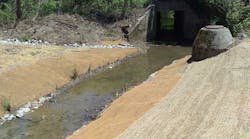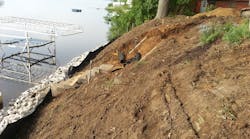The Snake River Valley of eastern Idaho didn’t become an agricultural center until well after the Civil War. The Homestead Act, which became US law in 1862, brought settlers determined to farm to the area.
The Homestead Act allowed any citizen of the US who was the head of the family or over 21 years of age to file a claim on 160 acres of unappropriated land. The claim filer could acquire title to the land by residing upon and cultivating it for five years.
The Snake River provided plenty of water, but it had to be brought closer to the farmers and ranchers. First the settlers cleared the land, then they dug canals and ditches to bring water where it was needed for crops and livestock. The canals played a critical part in the settlement of many parts of the western US. Now they serve an essential function in maintaining agriculture in these states.
One of these canals is the Porter Canal on the edge of what is now the city of Idaho Falls, ID. This canal was dug to supply water for gold mining and some farms. It was named for an investor in the mining firm. Over the years, relations between the farmers and the companies who owned the canals (and thus controlled the water the farmers needed for watering livestock and irrigating crops) changed. The farmers, many of Swedish descent, decided to form their own water supply company, and the New Sweden Irrigation District began in early 1900. Wheat, barley, oats, and corn were the first small grain crops planted. Every farm needed these grains as food for people and livestock. A disciple of Luther Burbank introduced another crop that became dominant in the late 19th century: the russet potato. This variety of potato—what people now call Idaho baking potatoes—thrived in the eastern Idaho climate of warm summers with cool nights. “We’re right in the middle of the potato-growing area. We also have a lot of grain and alfalfa,” says Kail Sheppard, manager of the New Sweden Irrigation District. Today the New Sweden Irrigation District manages the Porter Canal and other waterways in an area of 27,489 acres. The district is regulated by the Bureau of Reclamation, which is part of the US Department of the Interior. “We have a total of 25 different canals. They cover 125 miles,” says Sheppard. “We were the first irrigation district in the state of Idaho. We’re proud of that.” Operation of New Sweden Irrigation District’s canals is seasonal, following the work of the farmers and ranchers they serve. The canals are filled in mid-April in time for spring planting. After crops are harvested in the fall, the canals are drained (by gravity) and checked and repaired as needed. “We control the head gate to let water out of the river,” explains Sheppard. “It takes a week to fill the whole system of canals.” A small section of the Porter Canal adjoins land on which developers wanted to create Snake River Landing, a residential, retail, and office complex. But before development could begin, seepage from the Porter Canal had to be stopped. Xcell Engineering of Chubbock, ID, was hired to choose a liner for the Porter Canal and oversee its installation in 2007. Sheppard recommended a Canal3 geocomposite liner made by the Huesker Inc., a German firm with American headquarters in Charlotte, NC. “In some of our canals, these liners have been there for close to 10 years. So far, so good. We have issues with sinkholes caused by underground lava flows,” says Sheppard, adding that wildlife have not bothered the liners. Xcell’s owner, Paul Bastian, P.E., concurred with Sheppard’s recommendation of Huesker’s Canal3 to line the Porter Canal. “This material was purchased specifically because it was UV-resistant and wouldn’t deteriorate.” Bastian had used Canal3 on other projects. “I’ve been pleased with it. It works great.” [text_ad use_post='27664'] Canal3‘s distinctive characteristic is its multilayered composition. This geosynthetic material has a top and a bottom layer of nonwoven material. These layers sandwich a polyethylene membrane. The top and bottom nonwoven layers offer two advantages. They provide greater protection against punctures or rips and also increase interface friction. Because Canal3 comes from the Huesker factory already multilayered, it can be installed much more quickly than adding separate layers. Shaping and anchoring trenching are sufficient, as excavation is not needed. The project required 157,500 square feet of Canal3. Porter Canal runs for about 7 miles from the headwaters of the Snake River before it divides into other canals and streams. The portion that was lined was less than a half mile. The Porter Canal is about 60 feet wide at the top. Its sides slope downward about 7–8 feet. At the bottom it is only about 20 feet across, a convenient width for installing the liner. Bastian says the project’s major challenge was that “it had to be done quickly, in the early spring between the time the ground thawed and when water would be introduced into the canal. There would be no forgiveness. We had a hard deadline, with [water needed for] growing season approaching.” The project took about two months. Bastian says the liner was left uncovered because “it was cost-effective and any covering might slide down into the canal. Then it would have to be cleared out and doing that might tear the liner.” Because Canal3 is not subject to damage by the sun it can be left exposed, as was done at Porter Canal, or buried. If it is covered with shotcrete, Bureau of Reclamation studies show, it should last for 50 years.
One of these canals is the Porter Canal on the edge of what is now the city of Idaho Falls, ID. This canal was dug to supply water for gold mining and some farms. It was named for an investor in the mining firm.
Over the years, relations between the farmers and the companies who owned the canals (and thus controlled the water the farmers needed for watering livestock and irrigating crops) changed. The farmers, many of Swedish descent, decided to form their own water supply company, and the New Sweden Irrigation District began in early 1900.
Wheat, barley, oats, and corn were the first small grain crops planted. Every farm needed these grains as food for people and livestock.
A disciple of Luther Burbank introduced another crop that became dominant in the late 19th century: the russet potato. This variety of potato—what people now call Idaho baking potatoes—thrived in the eastern Idaho climate of warm summers with cool nights.
“We’re right in the middle of the potato-growing area. We also have a lot of grain and alfalfa,” says Kail Sheppard, manager of the New Sweden Irrigation District.
Today the New Sweden Irrigation District manages the Porter Canal and other waterways in an area of 27,489 acres. The district is regulated by the Bureau of Reclamation, which is part of the US Department of the Interior.
“We have a total of 25 different canals. They cover 125 miles,” says Sheppard. “We were the first irrigation district in the state of Idaho. We’re proud of that.”
Operation of New Sweden Irrigation District’s canals is seasonal, following the work of the farmers and ranchers they serve. The canals are filled in mid-April in time for spring planting. After crops are harvested in the fall, the canals are drained (by gravity) and checked and repaired as needed.
“We control the head gate to let water out of the river,” explains Sheppard. “It takes a week to fill the whole system of canals.”
A small section of the Porter Canal adjoins land on which developers wanted to create Snake River Landing, a residential, retail, and office complex. But before development could begin, seepage from the Porter Canal had to be stopped.
Xcell Engineering of Chubbock, ID, was hired to choose a liner for the Porter Canal and oversee its installation in 2007. Sheppard recommended a Canal3 geocomposite liner made by the Huesker Inc., a German firm with American headquarters in Charlotte, NC.
“In some of our canals, these liners have been there for close to 10 years. So far, so good. We have issues with sinkholes caused by underground lava flows,” says Sheppard, adding that wildlife have not bothered the liners.
Xcell’s owner, Paul Bastian, P.E., concurred with Sheppard’s recommendation of Huesker’s Canal3 to line the Porter Canal. “This material was purchased specifically because it was UV-resistant and wouldn’t deteriorate.”
Bastian had used Canal3 on other projects. “I’ve been pleased with it. It works great.”
Canal3‘s distinctive characteristic is its multilayered composition. This geosynthetic material has a top and a bottom layer of nonwoven material. These layers sandwich a polyethylene membrane.
The top and bottom nonwoven layers offer two advantages. They provide greater protection against punctures or rips and also increase interface friction.
Because Canal3 comes from the Huesker factory already multilayered, it can be installed much more quickly than adding separate layers. Shaping and anchoring trenching are sufficient, as excavation is not needed.
The project required 157,500 square feet of Canal3. Porter Canal runs for about 7 miles from the headwaters of the Snake River before it divides into other canals and streams. The portion that was lined was less than a half mile.
The Porter Canal is about 60 feet wide at the top. Its sides slope downward about 7–8 feet. At the bottom it is only about 20 feet across, a convenient width for installing the liner.
Bastian says the project’s major challenge was that “it had to be done quickly, in the early spring between the time the ground thawed and when water would be introduced into the canal. There would be no forgiveness. We had a hard deadline, with [water needed for] growing season approaching.”
The project took about two months. Bastian says the liner was left uncovered because “it was cost-effective and any covering might slide down into the canal. Then it would have to be cleared out and doing that might tear the liner.”
Because Canal3 is not subject to damage by the sun it can be left exposed, as was done at Porter Canal, or buried. If it is covered with shotcrete, Bureau of Reclamation studies show, it should last for 50 years.






